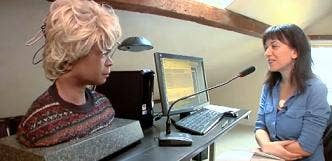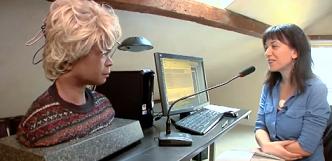NY Times Interviews Replicant While Its Owners Prepare for Digital Resurrection

Share
Modern robots don't make the best conversationalists. That's something that New York Times reporter Amy Harmon found out the hard way. She recently published her interview with Bina48, a robotic head created by Hanson Robotics based on the appearance and memories of a real human being - Bina Rothblatt. The $125,000 system was purchased by Martina Rothblatt, Bina's spouse and a ground breaking lawyer/entrepreneur in satellite radio technology. As you can see in the following video of Harmon's interview the pricey robot head looks cool, but like most chatterbots it produces a conversation full of confusion, distractions, and frustrations. Even with its limitations, Bina48 may be the herald of greater things to come. The Rothblatts, through their Terasem Movement Foundation, are pursuing artificial intelligence, longevity, and digital resurrection. Could we all live forever through replicants? Would anyone want to talk to us if we do?
Creating a digital version of yourself is a fairly common science fiction trope that may actually make its way into the real world. Robot manufacturers, like Hanson Robotics and Kokoro, are creating the hardware - animatronic shells with rubber skin that mimic human facial expressions. Hanson has had some success on the software side of things as well. His Phillip K. Dick replicant was able to talk and answer questions like the famous scifi author, and his Einstein robot, though not strictly aiming to reproduce the scientist's personality, is a much-sought-after robot on the conference circuit. The Bina48 robot is a little less polished than either of those predecessors, but it demonstrates how an average person could be translated into a digital program that speaks through a robotic clone.
Would this digitally resurrected version of yourself be recognizable as you? Not if we created it today. The Bina48 robot is an interesting device. It can make eye contact, and even recognize faces it knows (to some degree). Using an Internet connection it can get some deeper information to answer questions, and it's likely that it occasionally draws on Bina Rothblatt's data for some of its personality and desires (does the real Bina like to garden?). Yet its conversation skills seem no better than those chatbots that aren't based on real people. As Harmon writes in her NY Times article, prolonged interaction with Bina can lead to day dreams of strangling the robot.
So an average human is unlikely to be well translated into a computer medium. Not that the Rothblatt's are exactly your most average couple. Martina is a highly paid executive with a history of entrepreneurship in satellite radio and other telecomm industries. Bina likewise has experience in telecomm. Martina was also born a man and underwent sexual reassignment surgery, which she talked about on Howard Stern's satellite radio show. Perhaps it shouldn't be surprising that the first people who pursue digital copies of themselves are likely to have more financial means and unique perspective on identities than the average technophile.
Be Part of the Future
Sign up to receive top stories about groundbreaking technologies and visionary thinkers from SingularityHub.


I should also mention that Martina Rothblatt is one of the executive producers for Ray Kurzweil's The Singularity is Near film, whose New York debut we recently covered. That film discusses the creation of artificial life, as well as digital copies of ourselves. The rights of such 'individuals' is one of the key themes explored in the movie.
If the Rothblatts have their way, there could be many more such creatures. Their Terasem Movement Foundation is aimed at promoting the preservation and creation of human consciousness as digital life. Terasem regularly meets, discusses, and funds projects that may one day be able to create a computer copy of you. One of their projects, CyBeRev, is a sort of free online database where you can store your memories and documents in the hopes of one day using such information to create a digital avatar. They are a little limited on describing what technology will eventually be used to 'revive' you, but they accept a wide range of data (photos, writing, records) so there's a fairly good chance that something you upload would be helpful somehow. But even if you never use it, it is free of charge. We may not all have $125,000 to spend on robotic replicants, but the Rothblatts and Terasem seem determined to grant everyone the potential to recreate some semblance of themselves as artificial intelligence.
While Bina48 seems less than personable now, I expect the capabilities of robots like it to improve in the years ahead. Better animatronics and facial expression routines may pull these replicants out of the uncanny valley just as improved conversation algorithms will make interacting with them less frustrating. The bigger question is, of course, whether these human-based programs will ever actually be considered intelligent. If that does happen, will we consider them to be copies of their human counterparts, progeny, or a continuation of the biological organism in digital form. Just as we've used and updated the Turing test to qualify what counts as AI, we may need to come up with some means of determining if a digital version of yourself is really you (with all the rights that implies), or just an amazing simulacrum. Looking at Bina48 that test seems pretty easy for the moment. The robot may look like Bina Rothblatt, but it's far from human.
[screen capture and video credit: New York Times]
[sources: NYT, CyBeRev.org, Terasem Movement]
Related Articles

These Robots Are the Size of Single Cells and Cost Just a Penny Apiece

Hugging Face Says AI Models With Reasoning Use 30x More Energy on Average

Study: AI Chatbots Choose Friends Just Like Humans Do
What we’re reading

